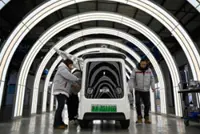With the help of little more than a smartphone, sensors and software, cars are now finding their own way around multi-storey car parks to park on their own. Just a gimmick? Not quite, because the underlying technology is being expanded. — dpa
MUNICH/STUTTGART: A quick tap on a smartphone app and your car is already finding a parking space in car park – and all without you having to sit behind the wheel. It's a dream come true for anyone with a phobia of parking garages (and for anyone in a hurry).
After front and rear beepers came cameras for a better overview when parking. Now the first models can drive themselves into the parking space without any human intervention.





